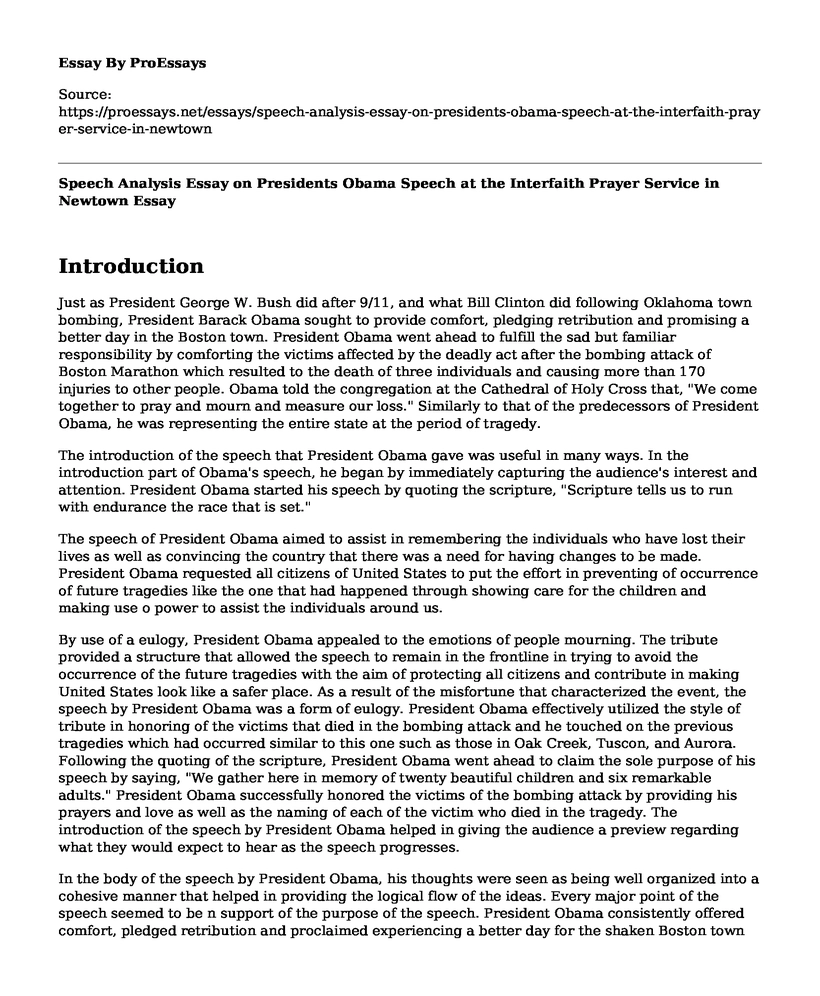Introduction
Just as President George W. Bush did after 9/11, and what Bill Clinton did following Oklahoma town bombing, President Barack Obama sought to provide comfort, pledging retribution and promising a better day in the Boston town. President Obama went ahead to fulfill the sad but familiar responsibility by comforting the victims affected by the deadly act after the bombing attack of Boston Marathon which resulted to the death of three individuals and causing more than 170 injuries to other people. Obama told the congregation at the Cathedral of Holy Cross that, "We come together to pray and mourn and measure our loss." Similarly to that of the predecessors of President Obama, he was representing the entire state at the period of tragedy.
The introduction of the speech that President Obama gave was useful in many ways. In the introduction part of Obama's speech, he began by immediately capturing the audience's interest and attention. President Obama started his speech by quoting the scripture, "Scripture tells us to run with endurance the race that is set."
The speech of President Obama aimed to assist in remembering the individuals who have lost their lives as well as convincing the country that there was a need for having changes to be made. President Obama requested all citizens of United States to put the effort in preventing of occurrence of future tragedies like the one that had happened through showing care for the children and making use o power to assist the individuals around us.
By use of a eulogy, President Obama appealed to the emotions of people mourning. The tribute provided a structure that allowed the speech to remain in the frontline in trying to avoid the occurrence of the future tragedies with the aim of protecting all citizens and contribute in making United States look like a safer place. As a result of the misfortune that characterized the event, the speech by President Obama was a form of eulogy. President Obama effectively utilized the style of tribute in honoring of the victims that died in the bombing attack and he touched on the previous tragedies which had occurred similar to this one such as those in Oak Creek, Tuscon, and Aurora. Following the quoting of the scripture, President Obama went ahead to claim the sole purpose of his speech by saying, "We gather here in memory of twenty beautiful children and six remarkable adults." President Obama successfully honored the victims of the bombing attack by providing his prayers and love as well as the naming of each of the victim who died in the tragedy. The introduction of the speech by President Obama helped in giving the audience a preview regarding what they would expect to hear as the speech progresses.
In the body of the speech by President Obama, his thoughts were seen as being well organized into a cohesive manner that helped in providing the logical flow of the ideas. Every major point of the speech seemed to be n support of the purpose of the speech. President Obama consistently offered comfort, pledged retribution and proclaimed experiencing a better day for the shaken Boston town and the entire United State. Through saluting Boston and its residents and talking to a crowd which included the former governor of Massachusetts who was once his opponent in the previous elections, President Obama said: "This attack on your beloved city has touched every one of us. Every one of us stands with you." This is an excellent way of involving everyone in the speech which helps in showing the significance of the role of the speech. In the body of the speech, President Obama used different examples in illustrating the major points of his speech, from facts to personal anecdotes and references. President Obama cited several iconic monuments located in Boston: Blooms of Boston Common and Public Gardens, gold dome of the statehouse, Red Sox's baseball and the annual celebration of the city of the Patriot's Day.
Furthermore, the body of the speech by President Obama was engaging and creative. While paying tribute to the resilience of Boston Town and entire America, the remarks made by President Obama were engaging since they were filled with the marathon and running metaphors, President Obama asserted that "We may be momentarily knocked off our feet, but we'll pick ourselves up. We'll keep going -- we will finish the race."
Conclusion
In concluding the speech, President Obama showed the balance of the statesman-like message to the state and the entire world through selecting the use of the moving words about compassion for the families and the local communities. President Obama signaled the end of his speech by use of a low tone. He ended with a grabber by asserting that: "Tomorrow the sun will rise over the the-this country that we love, this special place, this state of grace."
The delivery f the speech by President Obama was excellent as it engaged the audience through having the President maintaining eye contact with the crowd and use of different tonal qualities especially when the president wanted making a given emphasis.
Works Cited
AmericanRhetoric.com (2012). Barack Obama - Newtown Interfaith Prayer Vigil Addresshttps://www.youtube.com/watch?v=YmalVRadC78
https://www.youtube.com/watch?v=YmalVRadC78
Cite this page
Speech Analysis Essay on Presidents Obama Speech at the Interfaith Prayer Service in Newtown. (2022, Dec 02). Retrieved from https://proessays.net/essays/speech-analysis-essay-on-presidents-obama-speech-at-the-interfaith-prayer-service-in-newtown
If you are the original author of this essay and no longer wish to have it published on the ProEssays website, please click below to request its removal:
- Paper Example on Transfer Element in Successful Policies
- Police Unions Essay
- How U.S. Imperialism and Manifest Destiny Impact U.S. Workplaces Today - Essay Sample
- Texas Constitution Advocates Freedom of Sovereignty - Essay Sample
- Organizational Corruption: Five Bases of Power Affected - Essay Sample
- George Washington: Founding a Dual-Party System - Essay Sample
- Government Policies on Genetic Info for Felony Prevention - Essay Sample







